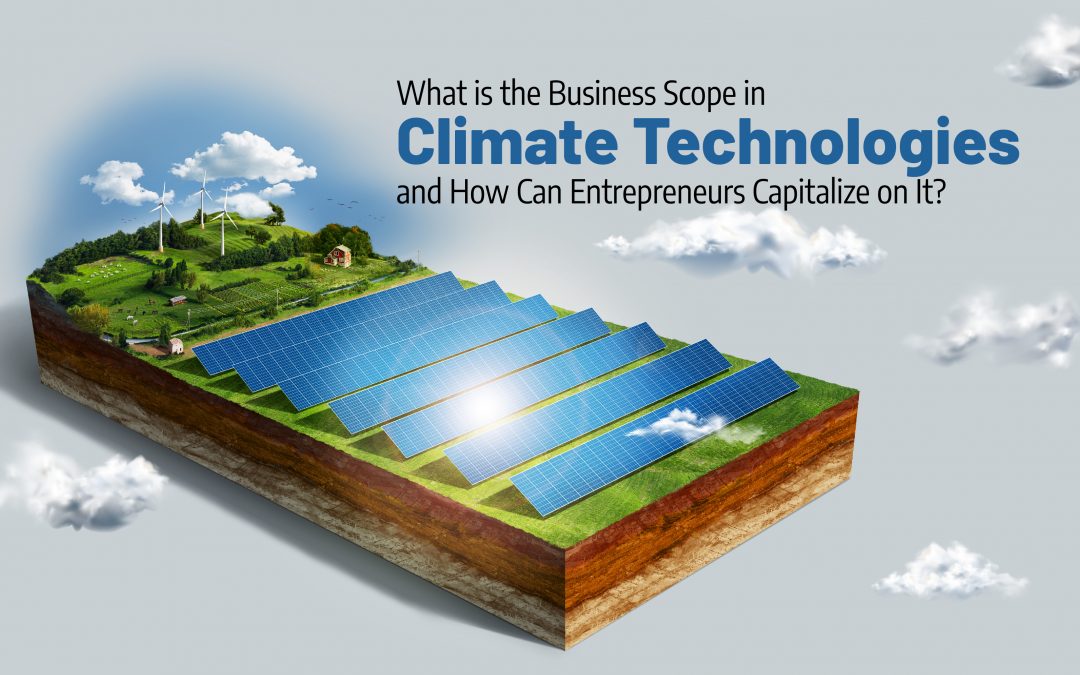As climate change continues to intensify, the demand for climate technologies—solutions aimed at mitigating or adapting to its effects—has surged. Entrepreneurs looking to enter this space have a unique opportunity to not only build profitable businesses but also make a significant impact on the environment. In this detailed exploration, we’ll delve into the various aspects of climate technologies, the scope for business, and trending techniques that entrepreneurs can leverage to capitalize on these opportunities.
1. Understanding Climate Technologies
Climate technologies are innovations designed to address the causes and impacts of climate change. They span across various industries and sectors, offering a broad range of solutions. Let’s break down some of the key areas:
- Renewable Energy: The renewable energy sector, including solar, wind, hydro, and geothermal energy, is expanding rapidly. According to the International Renewable Energy Agency (IRENA), the global renewable energy capacity reached 3,372 GW in 2022, a 9.1% increase from the previous year. Solar power alone accounted for 58% of this growth.
- Energy Storage: Energy storage technologies, such as lithium-ion batteries and emerging solid-state batteries, are critical for managing the intermittent nature of renewable energy. The global energy storage market is expected to grow at a CAGR of 22.2% from 2021 to 2026, reaching a value of $19.74 billion by 2026.
- Energy Efficiency: Technologies that reduce energy consumption are crucial in reducing overall carbon emissions. This includes smart thermostats, LED lighting, and energy-efficient appliances. The energy efficiency market is projected to grow at a CAGR of 10.4% from 2022 to 2028, driven by increasing regulatory standards and consumer awareness.
- Carbon Capture and Storage (CCS): CCS technologies capture CO2 emissions from industrial processes and store them underground. The global CCS market was valued at $3.4 billion in 2020 and is expected to grow at a CAGR of 13.7% from 2021 to 2028.
- Sustainable Agriculture: Innovations like precision farming, vertical agriculture, and regenerative farming practices are helping reduce the carbon footprint of food production. The global market for precision farming technologies is projected to reach $12.8 billion by 2027, growing at a CAGR of 12.7%.
- Waste Management: Advanced recycling technologies and waste-to-energy solutions are key areas of growth. The global waste management market is expected to reach $484.9 billion by 2025, growing at a CAGR of 5.6%.
- Water Management: Technologies that ensure sustainable water use are becoming increasingly important as water scarcity becomes a pressing issue. The global water management market is projected to grow from $297.2 billion in 2021 to $489.9 billion by 2028, at a CAGR of 7.3%.
2. The Business Scope in Climate Technologies
The climate tech market offers numerous opportunities for businesses across various sectors:
- Clean Energy Production: With the global push for decarbonization, clean energy is at the forefront. The International Energy Agency (IEA) reports that renewable energy will account for nearly 95% of the increase in global power capacity through 2026. Entrepreneurs can develop innovative renewable energy solutions, such as new solar panel designs or wind turbine technologies.
- Energy Storage and Smart Grids: As renewable energy sources become more prevalent, energy storage and smart grid technologies are essential. The global market for smart grids is expected to reach $61 billion by 2027. Startups can innovate in battery technology, grid management software, or decentralized energy systems.
- Sustainable Mobility: The electric vehicle (EV) market is booming, with global EV sales reaching over 10 million units in 2022, a 60% increase from 2021. Entrepreneurs can tap into this market by developing EV infrastructure, battery recycling technologies, or alternative fuel solutions like hydrogen fuel cells.
- Green Building Technologies: The construction industry contributes approximately 39% of global carbon emissions, making green building technologies crucial. The global green building materials market is projected to grow from $245 billion in 2020 to $523 billion by 2027. Innovations could include energy-efficient materials, smart home systems, or modular construction techniques.
- Climate Resilience Solutions: As climate impacts worsen, there’s a growing need for technologies that help communities and businesses adapt. This includes flood management systems, drought-resistant crops, and climate data analytics. The market for climate resilience technologies is expected to grow as governments and businesses invest in adaptation strategies.
3. How Can Entrepreneurs Capitalize on the Opportunity?
To effectively capitalize on the business opportunities in climate technologies, entrepreneurs should consider several strategic approaches:
- Identify Niche Markets: While the climate tech market is broad, focusing on a specific niche can help businesses stand out. For instance, instead of competing in the saturated solar panel market, a startup could focus on developing innovative energy storage solutions or specialized software for managing renewable energy assets.
- Example: Ampd Energy, a startup based in Hong Kong, focused on developing battery energy storage systems for construction sites, a niche within the broader energy storage market.
- Leverage Government Policies and Incentives: Governments worldwide offer incentives for businesses in the climate tech sector, such as tax credits, grants, and favorable regulations. Entrepreneurs should research and utilize these opportunities to lower startup costs and improve profitability.
- Example: The U.S. Inflation Reduction Act of 2022 includes $369 billion in funding for climate and clean energy programs, offering tax incentives for renewable energy projects and energy-efficient building upgrades.
- Collaborate with Established Companies: Partnering with larger, established companies can provide access to resources, expertise, and markets that would be difficult to reach independently. Such collaborations can also offer validation and credibility to startups.
- Example: Tesla’s partnerships with established car manufacturers like Toyota and Daimler in its early days helped it gain credibility and access to critical components.
- Focus on Innovation and Sustainability: Continuous innovation is crucial in the fast-evolving climate tech space. Entrepreneurs should prioritize research and development (R&D) and integrate sustainability into their business models, aligning with growing consumer and investor demand for environmentally responsible practices.
- Trending Technique: Circular economy models are gaining traction, where businesses design products for longevity, reuse, and recycling. This not only reduces waste but also creates new revenue streams.
- Attract Investment: The capital-intensive nature of climate technologies often requires external funding. Entrepreneurs should be prepared to attract investment from venture capitalists, impact investors, and government-backed funds focused on climate solutions.
- Trending Technique: Impact investing is a growing trend where investors seek financial returns alongside positive environmental impacts. In 2022, the global impact investing market was valued at over $715 billion, with a significant portion directed toward climate tech.
4. Challenges and Considerations
While the climate tech sector offers immense opportunities, entrepreneurs must also navigate several challenges:
- High Initial Costs: Developing and scaling climate technologies often require significant upfront investment. Entrepreneurs need to carefully plan their funding strategy, whether through venture capital, government grants, or strategic partnerships.
- Regulatory Hurdles: Navigating complex regulatory landscapes can be challenging, especially in highly regulated sectors like energy and transportation. Entrepreneurs must stay informed about relevant regulations and work closely with policymakers to ensure compliance.
- Market Adoption: While there is growing demand for climate technologies, convincing consumers and businesses to adopt new solutions can be difficult, especially if they require significant behavioral changes or upfront costs.
- Example: The adoption of electric vehicles was initially slow due to concerns about range, charging infrastructure, and cost. However, as these barriers have been addressed, EV adoption has accelerated.
- Long-Term Commitment: Climate tech ventures often require a long-term commitment, with returns that may not be immediate. Entrepreneurs need to be patient and resilient, with a focus on long-term value creation rather than short-term profits.
5. Trending Techniques in Climate Technologies
Several emerging trends are shaping the future of climate technologies, offering new opportunities for entrepreneurs:
- Artificial Intelligence (AI) and Machine Learning: AI and machine learning are being used to optimize energy consumption, predict climate impacts, and improve the efficiency of renewable energy systems. For example, AI-driven predictive maintenance can reduce downtime and extend the lifespan of wind turbines.
- Blockchain for Energy Trading: Blockchain technology is enabling peer-to-peer energy trading, where consumers can buy and sell excess renewable energy directly with each other. This decentralization of energy markets is creating new business models and revenue streams.
- Carbon Offset Platforms: As more companies commit to achieving net-zero emissions, there’s a growing market for carbon offset platforms that allow businesses to offset their carbon footprint by investing in environmental projects. Startups in this space are developing digital platforms that make it easier to purchase and manage carbon credits.
- Nature-Based Solutions: There’s a rising interest in nature-based solutions that use natural processes to address climate challenges. This includes reforestation, wetland restoration, and sustainable agriculture practices that sequester carbon and enhance biodiversity.
- Circular Economy Models: As mentioned earlier, the circular economy is a trending approach where products are designed for reuse, repair, and recycling. This model is gaining popularity in sectors like fashion, electronics, and packaging, offering new business opportunities in sustainable product design and waste management.
Conclusion
The business scope in climate technologies is broad and filled with potential. As the world moves toward a more sustainable future, the demand for innovative solutions that address climate change will only increase. Entrepreneurs who can identify and capitalize on these opportunities will not only contribute to a critical global cause but also position themselves at the forefront of a thriving industry. Now is the time to explore the possibilities and make a lasting impact through climate technologies.












